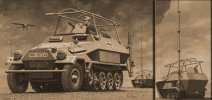I'd really like to see a revision of view ranges, spotting mechanics and OOBs (for recon elements, see below), as the current setup seems to deliver less historical settings.
German Recon strategies and tactics:
The Germans divided recon into three components, basically.
W.J.K. Davies, in his "German Army Handbook 1939-1945", gives a rough (but still valid) summary:
The first component was the Operational Reconnaissance (Operative Aufklärung), which was mainly conducted by air units, the seond component was the Tactical Reconnaissance (Taktische Aufklärung), ...... "which was carried out 15—20 miles in advance of an attacking force by motorised or armoured units specially organised for the task", and the third component was the Battle Reconnaissance (Gefechts Aufklarung) ,...... "which was close range reconnaissance as a Division or similar force moved in to engage an enemy".
He then stresses that...
"the latter pattern was the most important and, according to the principle whereby armoured units made the first thrust, was entrusted wherever possible to the armoured reconnaissance Abteilungen of the armoured Divisions. The 'standard' patrol consisted of three armoured cars operating on a narrow front and providing mutual observation and covering fire. In practice the lead vehicle was often used as a decoy, being driven close to suspected enemy positions and then withdrawing rapidly once it had exposed these by drawing their fire; this tactic was much aided by the double-ended design of standard German armoured cars (see p. 75), and since they were not expected to fight to nearly the same extent as allied formations, the vehicles were lighter and faster than their allied equivalents" [with max speeds of up to 90 km/h, and even 100 km/h (street) with engine upgrades on the 8-wheel scout cars].
German Recon Vehicles:
The most widely used "leichter Panzerspähwagen" (light armored scout car) for this task was based on the Sd.Kfz. 221 armored scout car (MG 34), which had 14.5 mm of armor on the front and 8 mm on the sides, where then upgraded revisions (eg. MG 34 + 20 mm KwK) were designated Sd.Kfz. 222, where Ausführung B, produced from 1940-1943, had 90 HP (3.8 L 8V-Horch engine, a max. speed of 90 km/h and a range of 347 km (street). The frontal armor was upped to 30 mm at some point. The Ausführung A, with its weaker 75-HP engine, featured a max. speed of ~ 80 km/h. The 222 series cars were used throughout the war and at least 2041 vehicles of the Sd.Kfz. 221/222/223 series were produced until 1944, where 708 of these had left the production lines before the war started. The 223 was the radio car version, equipped with a retractable frame antenna.
A Sd.Kfz 222 scout car in North Africa:
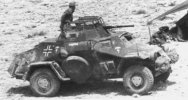
The fastest Panzerspähwagen versions were based on the "Panzerspähwagen" Sd.Kfz. 231 - 233 series (6 wheels on early versions - 70km/h, but the production focus quickly switched to producing cars with 8 wheels, due to the bad off-road capabilities of the smaller 6-wheeler), where the 8-wheel versions had the most interesting features:
A Sd.Kfz. 232 with shield:

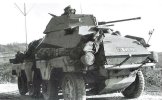
The "schwerer Panzerspähwagen" ("heavy armored scout car") Sd.Kfz. 234, featuring the glacis plate of the 231 series, had a Tatra 14.8 L engine, 220 HP, 8 wheels, and there were 2 fuel tank versions: 240 or 360 liters, which provided a range of 600 or 900 km (street), and 400 or 600 km (off-road), and a max. speed of 90 km/h (street).
The most famous version, the 234/2 "Puma", was one of the versions with the lowest 8-wheel-car production numbers:
Around 94 Pumas were produced in 1944 (7 in 1943), only, while around 531 Sd.Kfz. 231 + 232 (from 1939 - 1943), 289 Sd.Kfz 263 (1939 - 1943) and 191 Sd.Kfz 233 (1942-44) were produced during the war.
The "Panzerfunkwagen" Sd.Kfz 263 (Funk) was produced from 1937 - Jan. 1943, and it was rather a mobile/armored radio station, as it did not receive a turret (open top) and as it just received a MG 34 for self defense. The vehicle was equipped with the 9 m radio mast that was also mounted on halftracks (providing long-range radio coms, see picture with halftrack below), and with a retractable frame antenna.
"Once contact was established it was normal practice to try to build up a local superiority in numbers, calling on the reserve armoured infantry of the [Recon] battalion to enable scouting to be pushed forwards and enemy outposts to be driven in."
"Infantry as such were not normally expected to undertake offensive reconnaissance since the Infantry Divisions were intended only to consolidate and to mop up, but in specialised circumstances (eg mountain work or in other difficult terrain) they were used. In such cases, fighting patrols of up to 15-20 men — but more often 7-8 — were sent out in World War I fashion. They were armed mainly with automatic and semi-automatic weapons and were not expected to engage in serious and prolonged fighting. Their duty was to take prisoners if possible and to report. The practice of using infantry naturally became more common when the army was forced permanently on the defensive, and infantry Divisions then often had specialist bicycle or mounted units for mobile reconnaissance work."
It should be added that Infantry Divisions had their own organic (light infantry) Recon element, either a cavalry unit (literally on horses, early in the war), a bicycle Bn (where some Bns only had its 1st Coy equipped with bikes, depending on stage of the war), a Kradschützen-unit (motorbikes with side cars, the size ranged from a single Coy to a full Krad-Bn, until ~ 1942/early 1943, IIRC), or (rather rare, as the focus of car and vehicle deliveries was put on equipping units that were organized as fully motorized or armored Divisions/units) a halfway "motorized" unit (where the vehicle pool could range from trucks to scout cars or halftracks).
That said ... err ... and quoted, the following feature requests would be a good addition to enhance the depiction of historical procedures and tactics:
Recon feature requests for Command Ops:
German Tanks:
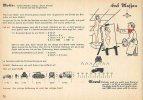
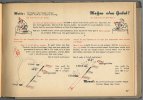
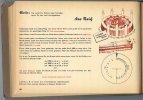

The US Army had figured that their optics were inferior during the African campaign, and then tried to get over the critical phase described by West Point historians as serious crisis. A board of officers and engineers/scientists gathered in 1943, to discuss how that crisis could be overcome, but as neither the US Army, nor engineers/scientists could find a solution for the problem with the blur (which increased with each lense that was added to enhance the magnification level), the only solution that could be implemented was to increase the magnification levels from 3x (North Africa) to 4x and 5x magnification. Especially the 5x reticles appeared to deliver a level of blur that turned all medium range shots above 800 meters into pure guesswork.
The Germans had developed a method that involved some special coating and/or treatment during the manufacturing process on each lense, reducing the amount of blur for each lense added (down to 4% IIRC, I'd have to look it up, I wrote a detailed article in the Battlefront forums in 2009, I'll post it as thread in the CO2 main forum), thus providing relatively clear views even at long ranges. The Russians analyzed the German lenses and tried to copy them. At least the IS-2 tank had halfway decent optics, and some of the TDs (SU, or ISU?), too.
German Flak guns:
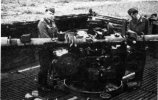
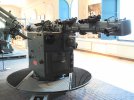
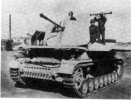
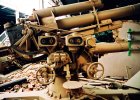
Currently, I do not see such employment of tank guns on INF targets or strongholds in the game, as it almost appears like the APersonnel range might be somewhat low (not sure if that's the case), I am also not sure whether flak 88s actually engage infantry in direct fire mode, or not. They surely do engage tank units with AP rounds in direct fire mode at ranges of up to ... say 2400 meters (my guess)?
Aerial recon in the game:
German Recon strategies and tactics:
The Germans divided recon into three components, basically.
W.J.K. Davies, in his "German Army Handbook 1939-1945", gives a rough (but still valid) summary:
The first component was the Operational Reconnaissance (Operative Aufklärung), which was mainly conducted by air units, the seond component was the Tactical Reconnaissance (Taktische Aufklärung), ...... "which was carried out 15—20 miles in advance of an attacking force by motorised or armoured units specially organised for the task", and the third component was the Battle Reconnaissance (Gefechts Aufklarung) ,...... "which was close range reconnaissance as a Division or similar force moved in to engage an enemy".
He then stresses that...
"the latter pattern was the most important and, according to the principle whereby armoured units made the first thrust, was entrusted wherever possible to the armoured reconnaissance Abteilungen of the armoured Divisions. The 'standard' patrol consisted of three armoured cars operating on a narrow front and providing mutual observation and covering fire. In practice the lead vehicle was often used as a decoy, being driven close to suspected enemy positions and then withdrawing rapidly once it had exposed these by drawing their fire; this tactic was much aided by the double-ended design of standard German armoured cars (see p. 75), and since they were not expected to fight to nearly the same extent as allied formations, the vehicles were lighter and faster than their allied equivalents" [with max speeds of up to 90 km/h, and even 100 km/h (street) with engine upgrades on the 8-wheel scout cars].
German Recon Vehicles:
The most widely used "leichter Panzerspähwagen" (light armored scout car) for this task was based on the Sd.Kfz. 221 armored scout car (MG 34), which had 14.5 mm of armor on the front and 8 mm on the sides, where then upgraded revisions (eg. MG 34 + 20 mm KwK) were designated Sd.Kfz. 222, where Ausführung B, produced from 1940-1943, had 90 HP (3.8 L 8V-Horch engine, a max. speed of 90 km/h and a range of 347 km (street). The frontal armor was upped to 30 mm at some point. The Ausführung A, with its weaker 75-HP engine, featured a max. speed of ~ 80 km/h. The 222 series cars were used throughout the war and at least 2041 vehicles of the Sd.Kfz. 221/222/223 series were produced until 1944, where 708 of these had left the production lines before the war started. The 223 was the radio car version, equipped with a retractable frame antenna.
A Sd.Kfz 222 scout car in North Africa:

The fastest Panzerspähwagen versions were based on the "Panzerspähwagen" Sd.Kfz. 231 - 233 series (6 wheels on early versions - 70km/h, but the production focus quickly switched to producing cars with 8 wheels, due to the bad off-road capabilities of the smaller 6-wheeler), where the 8-wheel versions had the most interesting features:
- all-wheel drive AND all-wheel steering
- forward and reverse speed were identical
- able to change direction (from full forward to full reverse) within 10 seconds (this includes the time needed for a full [hard] stop at max speed)
- 1 crew member served as reverse driver
- "bulletproof" tires (solid tires, most likely)
- engine: Büssing-NAG 8-cylinder engine (Ottomotor = gasoline engine) with 155 HP (max. speed: 90 km/h), and 180 HP (8.4 Liter) later on (max. speed: 100 km/h !!!).
The Sd.Kfz. 222's armor:
- armor (side): 8 mm
- frontal armor : ~14 mm
- armor (side): 8 mm
- frontal armor until 1940: 10-14 mm (particularly weak for a "heavy" scout car, one would think, but the "heavy" designation addressed such cars' weaponry - even AT and Inf guns, in the 234 series)
- Summer 1940 - late 1941: additional a frontal armor shield for the 231, which added some 8 or 10 mm of armor to the just slightly sloped and vulnerable front tip. It was mounted on the front tip with a distance of 50 cm between shield and frontal armor (to create some kind of early spaced armor, but also with the aim to produce deflections right on the shield)
- later on (date?): 30 mm (no shield necessary)
A Sd.Kfz. 232 with shield:

The Sd. Kfz. 232 (3rd series/revision):
- For instance, the Kradschützen-Bn 59, a recon element of the 9. Panzer-Division, had received vehicles of the 3rd "Serie" around January/February 1942, and they were still equipped with the front shield, even though the frontal armor appeared to be inaedequate at the time, already.
The Sd. Kfz. 232 (4th - 5th series series/revision):
- The front was now streamlined and the frontal armor had finally received an upgrade, featuring 30 mm of frontal armor. It had also received a gun upgrade, where - instead of the KwK 30 - the 20-mm KwK 38 was now in place, and the turret had received a slight redesign.
- 1942 - Dezember 1943 (phase-out): front 30 mm (no shield necessary). Some 232's were "downgraded" to 231's (by removing all extra radio equipment (frame antenna, medium range radio, etc.), as the 231 production - according to some sources - had ended in 1941 (officially at least), with only around 104 vehicles completed and the focus shifted to the production of the 232 and the 233. Other sources state that the production of the 231 ended as late as early 1943.

The "schwerer Panzerspähwagen" ("heavy armored scout car") Sd.Kfz. 234, featuring the glacis plate of the 231 series, had a Tatra 14.8 L engine, 220 HP, 8 wheels, and there were 2 fuel tank versions: 240 or 360 liters, which provided a range of 600 or 900 km (street), and 400 or 600 km (off-road), and a max. speed of 90 km/h (street).
The most famous version, the 234/2 "Puma", was one of the versions with the lowest 8-wheel-car production numbers:
Around 94 Pumas were produced in 1944 (7 in 1943), only, while around 531 Sd.Kfz. 231 + 232 (from 1939 - 1943), 289 Sd.Kfz 263 (1939 - 1943) and 191 Sd.Kfz 233 (1942-44) were produced during the war.
The "Panzerfunkwagen" Sd.Kfz 263 (Funk) was produced from 1937 - Jan. 1943, and it was rather a mobile/armored radio station, as it did not receive a turret (open top) and as it just received a MG 34 for self defense. The vehicle was equipped with the 9 m radio mast that was also mounted on halftracks (providing long-range radio coms, see picture with halftrack below), and with a retractable frame antenna.
"Once contact was established it was normal practice to try to build up a local superiority in numbers, calling on the reserve armoured infantry of the [Recon] battalion to enable scouting to be pushed forwards and enemy outposts to be driven in."
"Infantry as such were not normally expected to undertake offensive reconnaissance since the Infantry Divisions were intended only to consolidate and to mop up, but in specialised circumstances (eg mountain work or in other difficult terrain) they were used. In such cases, fighting patrols of up to 15-20 men — but more often 7-8 — were sent out in World War I fashion. They were armed mainly with automatic and semi-automatic weapons and were not expected to engage in serious and prolonged fighting. Their duty was to take prisoners if possible and to report. The practice of using infantry naturally became more common when the army was forced permanently on the defensive, and infantry Divisions then often had specialist bicycle or mounted units for mobile reconnaissance work."
It should be added that Infantry Divisions had their own organic (light infantry) Recon element, either a cavalry unit (literally on horses, early in the war), a bicycle Bn (where some Bns only had its 1st Coy equipped with bikes, depending on stage of the war), a Kradschützen-unit (motorbikes with side cars, the size ranged from a single Coy to a full Krad-Bn, until ~ 1942/early 1943, IIRC), or (rather rare, as the focus of car and vehicle deliveries was put on equipping units that were organized as fully motorized or armored Divisions/units) a halfway "motorized" unit (where the vehicle pool could range from trucks to scout cars or halftracks).
That said ... err ... and quoted, the following feature requests would be a good addition to enhance the depiction of historical procedures and tactics:
Recon feature requests for Command Ops:
- It would be desirable to have the fastest elements of a Recon Bn separated from the slower units, so that the player can perform fast scout runs with historical speeds and tactics .
- The game also needs a "hold fire" button, so that recon elements can stick to observing or maintaining visual contact from camouflaged positions or elevations, without engaging (and risking detection). Hiding/passive units (executing a "hold-fire" order) should be harder to detect.
- It should be possible to command, move and position VERY SMALL obs units (eg. the historical amount of 3 scout cars), and such units should be harder to detect once they are "deployed" (means camo'ed), as they would take advantage of key terrain features (say woods, right behind the crest of high elevations with clear views, etc.) in order to up the view range and to conceal their own movement/wherabouts.
- With their armored radio cars, the Recon Bns could also maintain radio contact with the Division HQ's Sd.Kfz 251/3, called "mittlerer Funkpanzerwagen" (= armored medium radio car, which was a halftrack, in fact), armored halftracks with a frame antenna AND a telescopic 9-m radio mast, providing medium and long range radio (depending on setup) coms. There were 9 different versions (due to the different radio setups/versions) and quite some crews/units created their own versions, eg. to liase with Luftwaffe units to coordinate combined attacks, using Luftwaffe frequencies. They were also used by the Luftwaffe and could also be used as mobile towers on airstrips:
- Sighting/view range usually outmatched the max. effective weapon range (of the observer's or the foe's small arms and light guns, as well as the effective view range [keyword: optics] of Allied AT or Tank guns).
- And, last but not least, a recon unit sitting on a hill usually saw the enemy before he saw the recon unit, especially under good weather conditions (quite some german hills in the Rhein and Mosel area, AND the Eifel area, north of the Huertgen area provide view ranges of up to 30-66 kilometers, on clear days, same goes for some hills near or just slightly North of the Huertgen area, and - afaik - also goes for one or another elevation in the Ardennes sector). A prominent example would be the Burgberg (near the town of Bergstein in the Eifel Region), where the roof of a bunker installation on the hill top was used by German artillery observers, who could then survey quite some movements and whereabouts of US troops during the several Battles of Hürtgen Forest. The hill was either ignored, or not identified as obs point by the Allies for months (and only the "Battle of Hill 400", with the final US assault to capture the hill top, then resulted in the Germans losing that obs point, the assault was featured in a "Call of Duty" mission, IIRC). Another German obs point might have been the "Signal de Botrange" in the High Fenn mountain region in Belgium, as its Baltia-hill (694 meters) forms the highest elevation in Belgium, and as it features a weather observation tower (built in 1933/34) that still exists.
German Tanks:
- During encounters of German heavy tanks with Allied Inf / AT guns in open terrain (desert, Russian Steppe, French, German or Dutch plains, the effective range of the tank guns usually outmatched the Inf's/AT's effective range. Superior German optics provided less blur, so that German tanks (this goes for the Tiger I [up to 4000 meters], the Panther [up to 4000 meters] and the Tiger II [up to 5000 meters target acquisition range with TZF9d gunsights], the Pz.IV had good optics, but less magnification levels for quite a while, Models G + H had the TZF5f/1 five times gunsights, which allowed for max. target acquisition ranges of up to 4000 meters, under favourable conditions) or Flak 88 units could engage Allied tanks or gun emplacements way before the enemy could reliably identify the German vehicle or gun emplacement and from way outside the enemy's effective view/engagement range. For instance, Allied M4 Sherman tanks just saw a rough blurry shape above 800-1000 meters.
- Tigers engaged gun emplacements and Inf positions in Russia between 2800 - 3000 meters (ballistic trajectory/aiming). The Tiger's manual encouraged the crews to trust the effectiveness (ie. range) of their gun and calculate the distances with range tables and the aid of the reticle markers.
- The Tiger I's manual was not a dry technical sheet, but a collection of hints, descriptions (of procedures) and aids, where text sometimes appeared rhyme form and where the descriptions were enriched with quite some funny comic illustrations. Since cartoons were very popular in the 1930 and 1940s (despite the fact that US cartoons were banned in Germany later on), Guderian, as tank arm inspector, and other officials, thought that this would make the content more catchy, so that it would be remembered more easily. This following page details distance measuring with the aid of the special reticle markers, where then the commander would call out the amounts of dashes to the crew, and where the crew then calculated the distance for him within seconds, while he kept watching the battlefield and where the gunner then would set the exact (calculated) distance on his visor (and thus the elevation of the gun). With this procedure, Allied tanks would be hit with the first round fired at distances of up to 1000-1200 meters, and with the first or 2nd round at around 1200 - 1400 meters:

- The "Tigerfibel" (the manual, but it translates to Tiger's spelling book or fibula, "Fibel" is actually on old term for a book to learn reading, just this Fibel was used to learn "tanking"
) also described how to combat fixed positions at long ranges (at 2700 meters in this example), detailing how to calculate (involved some basic formulas) the right visor settings, stressing that several series of ammunition (especially with HE rounds) varied in quality (and amount of propellant), but that they also had less velocity, so that at such distances a certain distance has to be added (ie. adding 100 meters on the visor after the second shot, which hit the ground at 2600 meters, to hit with the third shot. The manual pointed out that the 2 impact points/small craters could be used to measure the distance to the target. Even at distances of 2800-3000 meters, the 3rd HE-shot was usually a direct hit, with that method and with an experienced crew that did the calculations right (note: there was no guesswork involved):

- Below, you can see the Reticle of one of the sights of the Tiger. The reticle markers served as rangefinders (a certain amount of dashes - 4 dashes converted to 1 triangle - means triangles [triangles or just dots in the reticles of other nations], converted to a certain distance - depending on the enemy tank's facing, but the reticle also contained predefined measured sizes (= dots on the outer reticle ring), speeding up the process. A Russian T-34 rushing towards the Tiger and appearing at with the size of 4 "Strich(e)" (dashes) in the reticle, was 800 meters away, the max distance at which the Tiger I could penetrate the T-34's frontal glacis. If a T-34 was viewed from the side and if it appeared to be 3 dashes long (or wide) in the reticle, then the Russian tank was 2000 meters away.
- The manual kept coming up with such examples and fixed values. Detailed max effective ranges (on frontal, side and rear armor) for every enemy tank was listed in the ballistic table that was part of every German tank's "Deckeltasche", a bag that was part of every tank's inventory. The crews had to learn the ranges by heart, as well as the formulas for calculating the distances. Officially, the tank commander (and gunner) had (to know how) to do the calculations, but experienced/fast crews would help each other and speed up the process, in order to enable the tank to fire before the enemy tank had finished its target acquisition/distance calculation, or distance guesswork (in Sherman tanks)
:

- Other nations had dots and even triangles too, the Russian SU-100 with TSH-19 sight had the most detailed sight (with visor tables + triangles) of the Allied tanks, probably followed by the SU- and ISU-152 (but which both had no triangles). The German reticle could be adjusted to 2.5x and 5 x magnification.
- The Sherman gunsights had no such reticles/aids, they basically just featured a cross in the middle with a range graduation table below, which started from 0 with 200 yards increments (vertical dashes), but then switched to non-linear increments to the max value (of 4200 yards), which made it really hard to memorize gun elevations (thus distances) in between those 2 values, and there was no way to employ (fast) distance measuring. The horizontal dashes and spaces left and right were 5 mil increments of deflection (to the left or the right), and weren't supposed to help measuring distances. They could be used for measuring, I guess, but the result was more of a pile of guesswork, than serious distance calculation. The M70F telescope/reticle on the following picture was graduated for the 75 mm M61 armor piercing round, according to the marking at the reticle's top part. A US veteran outlined, as quoted by Zaloga in one of his books, that one hit at a German tank at distances at around 800 meters and above (above that range the targets appeared to be just blurry shadows in the US gunsights) involved 3-4 rounds in late 1944 (during the Battle of the Bulge, IIRC), employing a suicidal and time consuming trial-and-error method, while the German tanks usually fired (and hit) with the first round well above that range, and where they got hit by German tanks (even Panzer IV tanks) at 1200 meters with the first shot (and either without knowing where the shot came from, or without being able to return fire with aimed shots):

The US Army had figured that their optics were inferior during the African campaign, and then tried to get over the critical phase described by West Point historians as serious crisis. A board of officers and engineers/scientists gathered in 1943, to discuss how that crisis could be overcome, but as neither the US Army, nor engineers/scientists could find a solution for the problem with the blur (which increased with each lense that was added to enhance the magnification level), the only solution that could be implemented was to increase the magnification levels from 3x (North Africa) to 4x and 5x magnification. Especially the 5x reticles appeared to deliver a level of blur that turned all medium range shots above 800 meters into pure guesswork.
The Germans had developed a method that involved some special coating and/or treatment during the manufacturing process on each lense, reducing the amount of blur for each lense added (down to 4% IIRC, I'd have to look it up, I wrote a detailed article in the Battlefront forums in 2009, I'll post it as thread in the CO2 main forum), thus providing relatively clear views even at long ranges. The Russians analyzed the German lenses and tried to copy them. At least the IS-2 tank had halfway decent optics, and some of the TDs (SU, or ISU?), too.
German Flak guns:
- Flak 88s scored confirmed hits (tank kills) at ~2400 meters in North Africa, some German sources state 2800 meters (unconfirmed?).
- German Flak guns had complex targeting devices/mechanism, but even without the fixed rangefinder, Flak guns in the field had the right (and more) tools (devices) for range finding (than tanks), where as most of the US AA guns (say the 90 mm M "something") just had iron sights, basically:
- indirect fire/targeting (AA role):
- a range finder (called "E-Meßgerät" [E for Entfernung = distance/range, Meßgerät = measuring device] or Kommandogerät [= command device], which consisted of a set of prisms, which would deliver the exact range when both of the 2 viewports were congruent with the target. This device then transmitted the required angle, barrel elevation and fuze/detonator timer-settings (electrically) to the receivers (4 Flak guns per battery), so that the gunner just had to crank (rotate) the gun manually until the gun's aiming point registered with the settings transmitted by the command device, where he then just pushed the foot pedal down to fire the gun, when the gun was ready. At night and with low cloud layers, the FuMG "Würzburg" radar device was used to determine flight level, direction and speed via telephone, later on the conversion device "Malsi" was used to transmit the data electrically to the command device 41, where then the aiming procedure continued as described above. The 8.8-cm Flak 37 received a gun rammer, as manual loading was not possible anymore, due to the higher weights of the shells, with this particular model, but - according to German sources - the gun rammers of the Flak 36 guns were usually removed, to increase the RPM, as manual loading was way faster: 15 - 20 rounds/minute with a Flak 36, 20-25 rounds/minute with a Flak 41.
- I am not sure whether the Kommandogerät could be used for direct fire, or not.
The fixed version of the command device (Kommandogerät 40 "Helsinki)":

Command device "Kommandogerät 40" (similar to Kommandogerät 41) with mounted 4-meter-rangefinder for optical target acquisition and calculation of the predicted position:

Range finding with a portable rangefinder, which was mainly used on ground targets, but which also worked when targeting air units, of course:

- direct targeting (AT + AA role [against low level fighters/bombers and dive bombers]):
- The gunner 2 ("Kanonier 2" or just "K2") would target the enemy tank using the traverse aiming device with the gun's "Flakzielfernrohr 20" scope/gunsight, where then the value was transmitted electrically to the traverse leading device. Despite the electrical transmission, the gun still had to be traversed manually with hand wheels until the fire direction registered with the transmitted angle. A second crew member (called E-Meßmann = "distance measuring man"
) then operated the distance measuring device and determined the distance to the target, where the device was also used to compute the "predicted position" of the target (for a moving target). The data was then used and set by the gunner 1 (K1), who operated the elevation device, but probably also by the K2, for gun traverse on a target that was moving/turning to the side. Once the target aligned with the gun's adjusted aim point, or once the section chief (G.F. = Geschützführer) ordered to fire, the K2 hit the foot pedal.
Performance against armored targets:
- Contrary to the original intention, the successor, the 8.8-cm Flak 41, was mainly employed in a ground combat role, because of its high penetration power (velocity: 980 meters/second with the Pz.Gr. 39-1 (APCBC-HE), which was a Pz.Gr. 39 with a slighty different [855 mm] cartridge case - weight: 10 kg) and accuracy, units in North Africa had received the first production models as priority deliveries, per direct order from Hitler. Even though the usual AT engagement range with that gun was 600 - 1500 meters, the max spread was 50 cm (to the sides) and 40 cm (in height) at a distance of 1000 meters (max. height of trajectory = 1 meter), and only 1 meter (width and hight) at a distance of 2000 meters (max height of trajectory = 6 meters, resulting in a slighty curved long distance shot), with the slightly heavier PzGranate 39 (APCBC-HE grenade, weight: 10.2 kg, a shell that penetrated the armor and then detonated inside of the enemy tank, usually resulting in an instant kill/knockout). With the Pz.Gr. 40 (APCR - tungsten) round, the gun could penetrate 192 mm of armor at 1000 meters and 152 mm of armor at 2000 meters, and with the Pz.Gr. 39-1 (APCBC-HE) 159 mm (1000 meters) and 127 mm of armor (2000 meters), respecively, if I am not mistaken.
- The 8.8-cm Flak 36's max. velocity was around 795 meters/second (w/ Pz.Gr. 39), and could still penetrate ~ 88mm of armor at 2000 meters. With the lighter APCR (tungsten) round (7.30 kg), it could still penetrate slighty over 110 mm of armor at 2000 meters. With the Pz.Gr. 39 HL (HEAT), the gun penetrated 90 mm of armor across the board (up to the shell's max. effective range).
A Flak 88 on display at the Imperial War Museum Duxford. You can see the indicators for the K1 and/or the K2 gunner, the gunners had to align the gun with the predefined settings (displayed by the red indicators [i think] which are pointing downwards and which look like wireframed or outlined arrows [barely visible]):

Currently, I do not see such employment of tank guns on INF targets or strongholds in the game, as it almost appears like the APersonnel range might be somewhat low (not sure if that's the case), I am also not sure whether flak 88s actually engage infantry in direct fire mode, or not. They surely do engage tank units with AP rounds in direct fire mode at ranges of up to ... say 2400 meters (my guess)?
Aerial recon in the game:
- Some form of aerial recon (say like the german short range recon missions with the small/unarmed Fieseler Storch planes) unit, that could provide regional operational recon, would enhance the game's realism, for sure.
Last edited:
